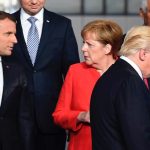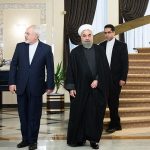by Gregory Brew
On May 8, the Center for Strategic and International Studies (CSIS) invited U.S. Special Representative Brian Hook to an event commemorating one year of the Trump administration’s “maximum pressure” campaign against Iran.
During the event, Hook briefly touched on the overthrow of Mohammed Mossadegh in the infamous coup of August 1953. “Mossadegh was overthrown by the religious establishment, the military, and the political leaders,” said Hook. “We have declassified a range of materials that speak to this,” referring to the retrospective volume of the Foreign Relations of the United States (FRUS) released in 2017.
Hook’s comment, though brief, is quite revealing. It references a position recently taken by a number of revisionists, who argue that the U.S. role in the downfall of Mossadegh was insignificant, and that the clerical class, the very same faction that would take over Iran after the 1979 revolution, was ultimately responsible for the coup of 1953.
Revisionists have gone so far as to label most of what is known about the coup as “myths,” ultimately disproven by a closer examination of the historical record, including the new FRUS volume.
This interpretation flies in the face of decades of scholarship. It represents an overt attempt to mislead, confuse, and misdirect people regarding the contents of the 2017 FRUS volume, which Hook either hasn’t read or is deliberately twisting to fit current U.S. policy.
There is considerable evidence that key clerical figures were involved in the plot against Mossadegh. But it’s misleading to argue that they played a preponderant role in a way that somehow links to the current politics and policies of the Islamic Republic.
Mossadegh had become quite unpopular with various sections of Iranian society by August 1953. His most important rival was Ayatollah Abolqasem Kashani, a popular cleric who had a considerable street following. Other figures, such as Ayatollah Mohammed Behbehani, also conspired against Mossadegh.
Kashani was a powerful figure chiefly due to his involvement in the campaign to nationalize Iran’s oil industry, which had been led by Mossadegh’s political coalition, the National Front. Kashani broke with Mossadegh for a variety of reasons, but few of them related directly to the former’s stature as a religious leader. More important clerical figures, particularly Ayatollah Hossein Borujerdi, the county’s most senior Shi’a cleric, took no part in the coup.
Finally, there is evidence to suggest that both Kashani and Behbehani received money from either the British or U.S. governments in order to secure their support in the campaign to oust Mossadegh.
The scholarly consensus around the coup has been quite consistent since historian Mark Gasiorowski’s groundbreaking 1987 article. The United States was heavily involved in the coup against Mossadeq. Indigenous factions were instrumental in Mossadegh’s overthrow. But the coup would not have taken place (or, at the very least, would have been significantly delayed) without funding, planning, and encouragement from U.S. officials.
The CIA had few assets inside Iran that could be used against Mossadegh. However, once the decision to mount a coup had been made, the British intelligence services handed over their Iranian network to CIA control. The British had wanted Mossadegh gone for years, yet British leaders knew that a covert operation was unlikely to succeed without American help.
The CIA disseminated propaganda designed to undermine Mossadegh. It bribed politicians and provided backing to General Fazlollah Zahedi, who coordinated pro-shah military forces on the day the coup and became prime minister once the operation ended.
The United States chose Zahedi not for his political ability but rather for his confidence and his willingness to take part in the coup. The Iranian leader openly admitted that U.S. help was needed, “that it is impossible for Iranians to remove the present government by their own efforts.” Zahedi also seemed amenable to negotiating an agreement with Western oil companies once he was in power.
The United States felt that any coup against Mossadegh would fail without the involvement of the shah. And yet the Pahlavi monarch had to be convinced, over a period of several months, to take part in the operation. The shah, understandably cautious, felt that even with U.S. help, the operation was dangerous and likely to fail.
The shah also argued that without a promise of U.S. economic aid, no change of government would be “preferable.” He would only participate if the United States promised to back his regime. The Eisenhower administration furnished the shah with a billion dollars of economic and military aid in the years immediately after 1953.
Documents in the FRUS volume indicate how the United States played a role in Iran’s internal politics before the coup. American officials were entangled in the July 1952 crisis and the February 1953 showdown between the shah and Mossadegh. In the latter instance, U.S. Ambassador Loy Henderson broke diplomatic protocol and sided with the monarchy against Iran’s prime minister.
The downfall of Mosaddegh was a complex, multi-tiered event that brought together disparate actors. Religious leaders played a role in the coup, and it would be a mistake to claim that the United States engineered Mosaddegh’s downfall single-handed. But the historical record is clear: without U.S. involvement, Mossadegh’s opposition would not likely have succeeded in August 1953. This was understood by key actors like Zahedi and the shah, and it is acknowledged by scholars today.
Hook notes that Iran’s current leaders “don’t want to remind people that the religious establishment at the time supported [Mossadegh’s] overthrow.” Indeed, the current regime has an ambivalent attitude toward Mossadegh, who is still an immensely popular figure among Iranians.
But Hook clearly hopes to conceal crucial facts. By shifting the blame for the coup he can absolve the United States of any lingering guilt over the toppling of Mossadegh. Through the weaponization of declassified documents, Hook and others in the Trump administration can use history to justify its current policy towards Iran. This kind of willful misinterpretation must be opposed if a broader understanding of the legacy of the 1953 coup is ever to be reached.
Gregory Brew is a post-doctoral fellow at the Center for Presidential History at Southern Methodist University, where he studies the history of U.S.-Iranian relations and international energy. His work has appeared in International History Review and Iranian Studies. Follow him at @gbrew24






Thanks for enlightening and highly unbiased article.
The revisionist claim overlooks years of anti-Mosadegh propaganda promoted by the CIA which included bombing a clerics house by “communists” who were actually CIA in their effort to cleave religious supporters away from Mossadegh.
Also there is no evidence Kashani took any money from the Brits.
Thank you Gregory Brew for exposing the uniformed, uneducated and stupid Iran team leader assigned by the ayatollah Pompeo! Hook is trying so hard to pin the blame for the Coup against Dr Mossadegh, democratically elected PM, on the clergy men is a desperate act or directive given to him by Pimpeo! It doesn’t work and the US has lost its credibility completely amongst the average people on streets of Iran and don’t believe a word coming out of DC!
For those of who lived through and remember the CIA satanic work in 1953 can not be convinced otherwise easily!
Mossadegh’s intransigence, put the people of Iran under incredible economic misery. He miscalculated the power of Iran’s oil. Very conveniently, he created an oil crisis, that brought more expensive oil regions of the world on stream. He did not know that Iran had oil, but not a distribution network. Funnily enough the Ayatollahs are doing the same now. In summary, too many ambitious Iranian politicians, think that they are very powerful when they are not. Iran is losing market share every day, because of their reckless behaviour. Just wait for a new war to bring about peak oil, that will isolate Iran with little market share.
Read Farmanfarmians book “Blood and Oil; Memoires of a Persia. Prince” about how the Brits were keeping two sets of books to cheat Iran. You people are shameless liars and totally discredited among Iranians.